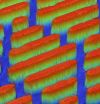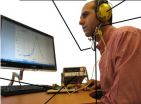(Press-News.org) PROVIDENCE, R.I. [Brown University] — Right now no one can say whether yoga provides clinical benefits to people with bipolar disorder, but in a new article in the Journal of Psychiatric Practice, researchers report survey responses they gathered from scores of people with the condition who practice yoga. What the collective testimony suggests is that yoga can be a substantial help, but it sometimes carries risks, too.
"There is no scientific literature on hatha yoga for bipolar disorder," said lead author Lisa Uebelacker, associate professor (research) of psychiatry and human behavior in the Alpert Medical School of Brown University and a staff psychologist at Butler Hospital. Hatha yoga is the practice, familiar in the West, in which people move between various poses. It often includes breathing practices and meditation. "There is reason to think that there are ways in which it might be wonderful and ways in which it might not be safe. We are interested in studying hatha yoga for bipolar as an adjunctive treatment to pharmacotherapy."
The preponderance of responses from more than 70 people who answered the study's online survey were that yoga has benefits for people with bipolar disorder. When asked, "What impact do you think yoga has on your life?" the vast majority of responses were positive and about one in five respondents characterized yoga as "life changing." One even said, "Yoga has saved my life. ... I might not be alive today were it not for yoga."
Twenty-nine other respondents said yoga decreased anxiety and promoted calm or provided other emotional benefits. Calm also emerged as a specific benefit for 23 survey respondents when asked how yoga affects mania symptoms. Other benefits that were mentioned repeatedly included distraction from depressive thoughts and increased clarity of thought.
"There is clearly evidence that yoga seems to be a powerful practice for some individuals with BD," the researchers wrote in the paper. "It was striking that some of our respondents clearly believed that yoga had a major positive impact on their lives."
Throughout the survey there was also evidence that yoga could be problematic for some people with BD, although fewer people cited problems.
In response to survey questions about whether yoga has had a negative impact, for example, five respondents cited cases in which rapid or energetic breathing made them feel agitated. Another became too relaxed after a slow, meditative practice: "I fell into a relaxed state ... near catatonic as my mind was depressed already. I was in bed for three days afterward."
And like some people in general who practice yoga, 11 respondents warned that there is the potential for physical injury or pain. Another four said they became self-critical or frustrated with their performance sometimes during yoga.
"It's possible that you want to avoid any extreme practice, such as extended periods of rapid breathing," Uebelacker said. The survey also raised some concerns about heated yoga, which is consistent with evidence that the use of certain medications for bipolar disorder, including lithium and antipsychotic medications, are associated with possible heat intolerance and resulting symptoms of physical illness.
Next: A Pilot Clinical Trial
The online survey is the first stage in a research program that Uebelacker, who has spent several years studying yoga for unipolar depression, and colleague Lauren Weinstock, an expert in bipolar disorder, are developing to examine yoga for bipolar disorder. They now have a grant from the Depressive and Bipolar Disorder Alternative Treatment Foundation to run a pilot clinical trial in which they will compare outcomes from yoga to outcomes from using a well-regarded workbook for bipolar disorder.
Those results could set the stage for a larger trial with enough statistical power to rigorously identify benefits and risks, Uebelacker said.
For many bipolar patients, symptoms persist for decades despite multiple medications. The current studies of yoga, Uebelacker said, are part of a broader program at Butler and Brown to determine what else can help people who are already undergoing conventional therapies.
"We're looking at alternative ways to cope with suffering that is part of people's everyday lives so that there are other options in addition to ongoing medication and psychotherapy" Uebelacker said.
As their research continues, they will learn what role hatha yoga might play.
INFORMATION:
In addition to Uebelacker and Weinstock, another author on the paper is Morganne Kraines of Oklahoma State University.
Survey finds benefits, risks of yoga for bipolar disorder
2014-09-17
ELSE PRESS RELEASES FROM THIS DATE:
Cape Cod saltmarsh recovery looks good, falls short
2014-09-17
PROVIDENCE, R.I. [Brown University] — After decades of decline, grasses have returned to some once-denuded patches of Cape Cod's saltmarshes. To the eye, the marsh in those places seems healthy again, but a new study makes clear that a key service of the marsh – coastal protection – remains diminished.
"We've got the aesthetics back but the ecosystem function hasn't come back," said ecologist Mark Bertness, professor of biology at Brown and senior author of the study in the journal Biological Conservation. "The metric of a recovered habitat should not be 'Does it look ...
Recruiting bacteria to be technology innovation partners
2014-09-17
For most people biofilms conjure up images of slippery stones in a streambed and dirty drains. While there are plenty of "bad" biofilms around – they even cause pesky dental plaque and a host of other more serious medical problems – a team at the Wyss Institute for Biologically Inspired Engineering at Harvard University sees biofilms as a robust new platform for designer nanomaterials that could clean up polluted rivers, manufacture pharmaceutical products, fabricate new textiles, and more.
In short, they want to give biofilms a facelift, and have developed a novel protein ...
Phthalates heighten risk for childhood asthma
2014-09-17
Researchers at the Columbia Center for Children's Environmental Health at the Mailman School of Public Health are the first to demonstrate an association between childhood asthma and prenatal exposure to two phthalates used in a diverse array of household products. Results appear online in the journal Environmental Health Perspectives.
Children born to mothers exposed during pregnancy to higher levels of the chemicals, butylbenzyl phthalate (BBzP) and di-n-butyl phthalate (DnBP) had a 72 percent and 78 percent increase in risk of developing asthma between age 5 and 11, ...
New study examines the impact of socioeconomic position & maternal morbidity in Australia
2014-09-17
The risk of severe maternal morbidity amongst women in Australia is increased by lower socioeconomic position, suggests a new study published today (17 September) in BJOG: An International Journal of Obstetrics and Gynaecology.
Australians generally enjoy high standards of living; however, existing research has concluded that health disparities exist, in particular between indigenous and non indigenous Australians.
This case-control study aimed to explore the independent impact of socioeconomic position on severe maternal morbidities associated with direct maternal ...
A greater focus on socially disadvantaged women is needed to improve maternity care in England
2014-09-17
Women from lower socioeconomic groups in the UK report a poorer experience of care during pregnancy and there needs to be a greater focus on their care, suggests a new study published today (17 September) in BJOG: An International Journal of Obstetrics and Gynaecology (BJOG).
Differences in health outcomes amongst different socioeconomic groups have been demonstrated in many areas and have provided the focus for national initiatives in the UK to reduce the observed inequalities.
The Oxford University study, funded by the National Institute for Health Research, explores ...
NAMS issues first comprehensive recommendations on care of women at menopause and beyond
2014-09-17
CLEVELAND, Ohio (September 17, 2014)—The North American Menopause Society (NAMS) has published its key, evidence-based recommendations for the comprehensive care of midlife women—on everything from hot flashes to heart disease. The special feature, "The North American Menopause Society Recommendations for Clinical Care of Midlife Women," was published online today in the Society's journal Menopause. This is the first, comprehensive set of evidence-based recommendations for the care of midlife women freely available to all clinicians who care for women at this stage of life. ...
Sharks' skin has teeth in the fight against hospital superbugs
2014-09-17
Transmission of bacterial infections, including MRSA and MSSA could be curbed by coating hospital surfaces with microscopic bumps that mimic the scaly surface of shark skin, according to research published in the open access journal Antimicrobial Resistance and Infection Control.
The study modelled how well different materials prevented the spread of human disease bacteria through touching, sneezes or spillages. The micropattern, named Sharklet™, is an arrangement of ridges formulated to resemble shark skin. The study showed that Sharklet harboured 94% less MRSA bacteria ...
Violent origins of disc galaxies probed by ALMA
2014-09-17
An international research group led by Junko Ueda, a Japan Society for the Promotion of Science postdoctoral fellow, has made surprising observations that most galaxy collisions in the nearby Universe — within 40 million light-years from Earth — result in so-called disc galaxies. Disc galaxies — including spiral galaxies like the Milky Way and lenticular galaxies — are defined by pancake-shaped regions of dust and gas, and are distinct from the category of elliptical galaxies.
It has, for some time, been widely accepted that merging disc galaxies would eventually form ...
Global shift away from cars saves US$100 trillion, eliminates 1,700 MT of CO2 pollution
2014-09-17
NEW YORK (17 September, 2014)—More than $100 trillion in cumulative public and private spending, and 1,700 megatons of annual carbon dioxide (CO2)—a 40 percent reduction of urban passenger transport emissions—could be eliminated by 2050 if the world expands public transportation, walking and cycling in cities, according to a new report released by the University of California, Davis, and the Institute for Transportation and Development Policy (ITDP).
Further, an estimated 1.4 million early deaths could be avoided annually by 2050 if governments require the strongest ...
'Smart material' chin strap harvests energy from chewing
2014-09-17
A chin strap that can harvest energy from jaw movements has been created by a group of researchers in Canada.
It is hoped that the device can generate electricity from eating, chewing and talking, and power a number of small-scale implantable or wearable electronic devices, such as hearing aids, cochlear implants, electronic hearing protectors and communication devices.
The first results of the device's performance have been published today, 17 September, in IOP Publishing's journal Smart Materials and Structures.
Jaw movements have proved to be one of the most promising ...




